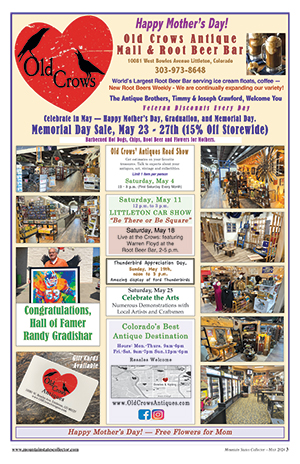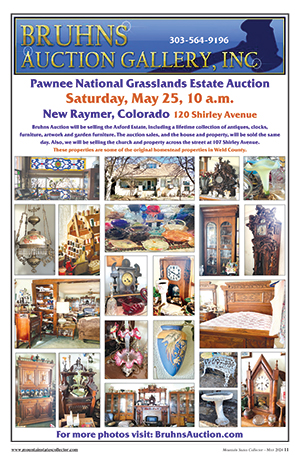 By Maureen Timm
By Maureen Timm Gorgeous Glass Grenades and Bottles Extinguished Fires of Yesteryear. Have you ever wondered what they had to quench a fire with in the old days, before the invention of flame-retardant chemicals and foam filled canisters? As a matter of fact, they had an arsenal of their own in the form of liquid-filled fire grenades.
Fire grenades originated in England during the late 18th century. The fire grenade was a bottle made of thin and very fragile glass designed to be thrown on the fire and to break easily. The contents were aimed at the base of the fire to quench the flames, and the grenades were designed to be light and easily handled. Grenades could be found in homes, hotels, factories, schools, trains and other commercial buildings around the turn of the century.
Various fluids have been used in the grenade and the most effective was found to be carbon tetrachloride. It was discovered that the carbon tetrachloride, when inhaled, caused respiratory problems and the liquid was then changed to salt water.
Alanson Crane was granted the first American patent for a fire grenade and around 1870, glass fire grenades became popular in the United States. These bottles were used until around 1910 when they were gradually replaced by the metal fire extinguisher we know today.
Fire grenades are usually six to eight inches high, with a narrow neck and a round body. Many grenades were sealed with a cork and cement. The cement would prevent the liquid from escaping if the cork shrank. For added protection, some grenades had a foil seal over the cork. Many grenades had a wire loop on the neck which was used for hanging the grenade from a nail or hook on the wall. Some manufacturers sold two or three fire grenades in a wire basket.
Between 1900 and 1920, fire grenades resembling light bulbs could be purchased with a special bracket. This bracket had a spring device and a fusible link. When the fusible link melted, the spring would cause a metal arm to shatter the grenade and release its contents into the fire. Fire grenades of this era came in a metal case, such as the Shur-Stop Kit that contained six grenades.
 One of the most famous manufacturers of fire grenades was the Harden Hand Fire Extinguisher Company of Chicago. Harden made grenades in 1-1/2 pints and one quart sizes. These grenades featured an embossed star with vertical ribs or a diamond quilted pattern. Early examples were made with a footed base. The glass color was usually light blue or cobalt blue. Harden’s grenades are the most common of known types of fire grenades.
One of the most famous manufacturers of fire grenades was the Harden Hand Fire Extinguisher Company of Chicago. Harden made grenades in 1-1/2 pints and one quart sizes. These grenades featured an embossed star with vertical ribs or a diamond quilted pattern. Early examples were made with a footed base. The glass color was usually light blue or cobalt blue. Harden’s grenades are the most common of known types of fire grenades. Harden manufactured a rare grenade in 1889. This grenade was made in three separate sections and was held together with wire. One section was clear glass, the second section amber and the third section cobalt blue. Another large producer of fire grenades was Hayward’s Hand Fire Grenade, located in located in New York. Their grenades were produced in blue, green, amber and smoke.
Babcock made a fire grenade called the Babcock Hand Grenade Non-freezing. Grenades were manufactured in blue, green, clear and amber colored glass.
A company named Barnum made fire grenades, including the Diamond brand. Diamond grenades were made in three and four-sided designs. These grenades are clear glass and have a patent date of 1869.
Fire grenades were also made for railroad cars. A grenade was made with the markings C & NW Ry., indicating it was used by the Canadian & Northwestern Railway.
Fire has alarmed mankind for centuries and these grenades were designed to extinguish small fires. In an era when portable fire extinguishers were unknown, the fire grenade provided a minimum amount of extinguishing capability.
Fire extinguisher bottles are similar to grenades. They were made of glass and designed to extinguish fires. Fire grenades were made to be destroyed in case of fire. Many extinguisher bottles were filled with a dry chemical that could be shaken out onto a. fire. Fire extinguisher bottles were mounted on early automobiles in case of engine fires.
The Dri Gas Fire Extinguisher manufactured in Chattanooga, Tennesse is a popular extinguisher bottle to collect. This clear 13′ bottle has a diamond quilted pattern and was filled with a sandy colored, dry chemical. The directions on the bottle state: Throw contents forcibly at the base of the fire by quick swinging motions.
The Larkin Fire Extinguisher was a bottle made of brown glass that contained a dry chemical. It had a paper label, a bottle cap style top and mounting bracket. These grenades are popular with collectors as they were made in many unique shapes and patterns. Many grenades are embossed with the name of the manufacturer, such as Harden’s, Hayward’s, Babcock, Harkness, Little Giant, Comet, to name a few.
When purchasing a grenade or extinguisher bottle, check for cracks, chips or repairs to the glass. Try to find examples with the original seal and contents. Many bottles can be found without their contents and are still prized by collectors. Some grenades are quite rare, such as a clear Hardens, or a light green Hayward. Harden’s star fire extinguisher sells for $100 and up and the rare colors are priced in the hundreds. Rare grenades in excellent repair are priced from $2000 and up.
S. F. Hayward published a catalog in the late 18008 describing its glass grenade fire extinguishers as “glass globes” of about four inches in diameter filled with a chemical fluid which generates enormous volumes of extinguishing gas when brought into contact with fire. As the bottle is hermetically sealed and the fluid itself is not susceptible to the influence of the atmosphere, no fermentation or evaporation can take place. It is in fact a cheap, simple and durable fire extinguisher that will not freeze, and can be used by man, woman, or child.
Sizes ranged from half-pint to two quart, the most common sizes being pints and quarts. The contents contained such simple chemicals as saltwater, bicarbonate of soda, and muriate of ammonia. The addition of salt allowed the grenade to be advertised as non-freezing. Corks were cemented in to prevent evaporation. The grenade came into existence around 1868 and lost its appeal about 1903.
Bottles can be found in many places such as farm houses, local auctions, under porches, basements, attics, old homes, flea markets, antique shops and antique bottle shows. You can dig in the trash pit or privy of an old house. Over a hundred years ago it was common practice to throw garbage into the privy or local trash pit. The most rewarding digging can be found in the East where most of the glasshouses were first settled. The Western States also have an abundance of good digging areas, which can be attributed to the gold rush in the late 19th century.
While their fire-extinguishing days are long over, fire extinguisher grenades and bottles make a lovely and attention getting addition to any glass collection. Their jeweled tones and unique shapes are sure to elicit spirited conversation – just see how long it takes guests to figure out their original purpose!

















Follow Us